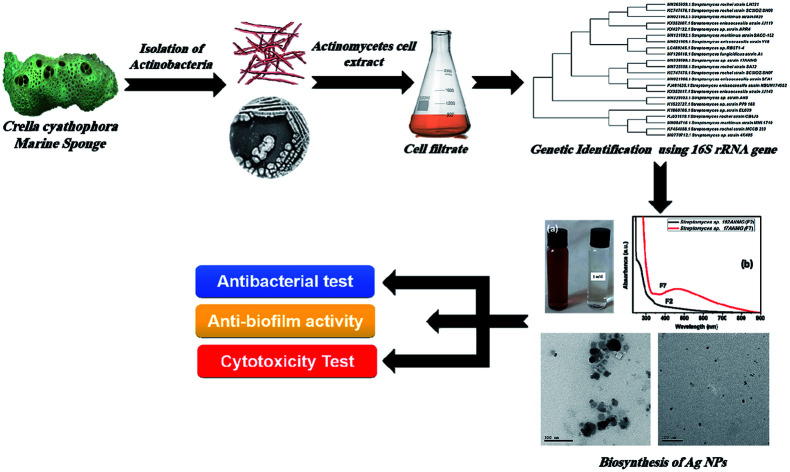- Record: found
- Abstract: found
- Article: found
Antibiofilm, antimicrobial and cytotoxic activity of extracellular green-synthesized silver nanoparticles by two marine-derived actinomycete†

Read this article at
Abstract
The increase in antibiotic resistance related to microbial biofilms creates an urgent need to search for an alternative and active antimicrobial agent. Recently, nanoparticles have gained considerable attention from scientists due to their potent antimicrobial activity. In the present study, two endosymbiotic actinomycete strains were isolated from marine sponge Crella cyathophora by surface sterilization and incubation of sponge pieces on culture media selective for actinobacteria. The culture filtrate extracts, including the bacterial supernatants (F) and cell filtrate (C) of the two actinomycete strains, were used as the reducing agent for the green biosynthesis of silver nanoparticles. The as-prepared silver nanoparticles were characterized using dynamic light scattering, zeta-potential, UV-Vis spectroscopy, and transmission electron microscopy. The average particle size for synthesized silver nanoparticles was about ∼8.66 ± 2 to 35 ± 2 nm with monodisperse spherical-like shapes and polydispersed shapes, respectively. The synthesized silver nanoparticles exhibited significant antimicrobial activity toward pathogenic microbes, especially with P. aeruginosa and E. cloacae. The effect of silver nanoparticles on the growth curve dynamics of P. aeruginosa and E. cloacae showed that the slope of the bacterial growth curve continuously decreased with increasing nanoparticle concentration. Moreover, the antibiofilm activity of the silver nanoparticles was measured, and the results showed that the silver nanoparticles displayed high biofilm inhibition activity against P. aeruginosa, B. subtilis, and S. aureus. Furthermore, silver nanoparticles exhibited a low to moderate cytotoxic effect against hepatocellular carcinoma cancerous cells, which reflect its possible use in the biomedical field.
Abstract
Culture filtrate of 2 actinomycetes extracted from marine sponge Crella cyathophora was used for the biosynthesis of AgNPs with a significant anti-microbial and biofilm activity. Also, AgNPs exhibited a low to moderate cytotoxicity against cells.

Related collections
Most cited references4
- Record: found
- Abstract: not found
- Book: not found
Nanomaterials : Synthesis, Properties and Applications, Second Edition
- Record: found
- Abstract: not found
- Book: not found
Nanomaterials: synthesis, properties and applications
- Record: found
- Abstract: not found
- Book: not found